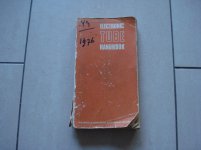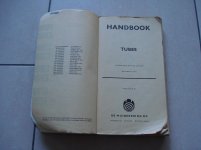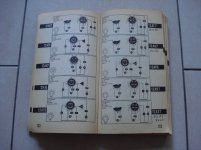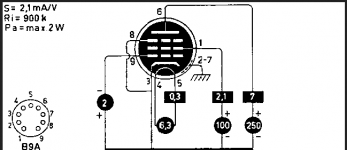Is there a forum member that actually saw an EF88 and/or has more information on this tube type?
As far as I know, the EF88 is only mentioned in "Comprehensive Valve Guide, Book 3, (Babani, 1960), in the seventh and later editions (so from 1961 going) of the "Electronic Tube Handbook" (Muiderkring) and in later editions of the AVO Valve Data Manual for Avo tube testers.
On Radiomuseum.org the EF88 has its own page, but I suspect this to be the result of the EF88 being mentioned in the Muiderkring handbook since the diagram for the EF88 comes from that handbook. The diagram does not show more information than de Babani guide does. Probably Muiderkring based their diagram on the data from the Babani guide.
EF 88, Tube EF88; Rohre EF 88 ID3876, Vacuum Pentode
At first sight it appears that there is some more info, like the pin-out diagram from a Telefunken handbook and a picture of the bottom side of the valve. But I could not find the EF88 in any Telefunken or Siemens handbook (but ofcourse I don't have acces to all their handbooks), so I suspect Radiomuseum.org used the pin-out diagram of the EF86 (or an other pentode with identical pin-out). And since the same picture of the bottom side of a Noval valve is also used on some pages of other Noval valves (mostly in cases where an actual picture of the valve type is not available) it is probably not a picture of the bottom side of an EF88.
The E88F surely does exist, but that is an EF80 intended to be used with an Noval to Loctal-8 adapter (the Philips/Mullard factory code on that E88F is identical to the factory code of the EF80). Since the pin-out and most of the other data of the EF80 are very different than that of the EF88, there seems to be no connection between the EF88 and the E88F (like for instance there is no connection between the EL81 and the E81L, the EF80 and the E80F, etc.).
E 88F, Tube E88F; Rohre E 88F ID51021, Vacuum Pentode
So to me the EF88 is a mistery. I never even saw a picture of one, let alone a datasheet with curves.
Earlier I posted this question on forums in The Netherlands and in the UK but without any result.
As far as I know, the EF88 is only mentioned in "Comprehensive Valve Guide, Book 3, (Babani, 1960), in the seventh and later editions (so from 1961 going) of the "Electronic Tube Handbook" (Muiderkring) and in later editions of the AVO Valve Data Manual for Avo tube testers.
On Radiomuseum.org the EF88 has its own page, but I suspect this to be the result of the EF88 being mentioned in the Muiderkring handbook since the diagram for the EF88 comes from that handbook. The diagram does not show more information than de Babani guide does. Probably Muiderkring based their diagram on the data from the Babani guide.
EF 88, Tube EF88; Rohre EF 88 ID3876, Vacuum Pentode
At first sight it appears that there is some more info, like the pin-out diagram from a Telefunken handbook and a picture of the bottom side of the valve. But I could not find the EF88 in any Telefunken or Siemens handbook (but ofcourse I don't have acces to all their handbooks), so I suspect Radiomuseum.org used the pin-out diagram of the EF86 (or an other pentode with identical pin-out). And since the same picture of the bottom side of a Noval valve is also used on some pages of other Noval valves (mostly in cases where an actual picture of the valve type is not available) it is probably not a picture of the bottom side of an EF88.
The E88F surely does exist, but that is an EF80 intended to be used with an Noval to Loctal-8 adapter (the Philips/Mullard factory code on that E88F is identical to the factory code of the EF80). Since the pin-out and most of the other data of the EF80 are very different than that of the EF88, there seems to be no connection between the EF88 and the E88F (like for instance there is no connection between the EL81 and the E81L, the EF80 and the E80F, etc.).
E 88F, Tube E88F; Rohre E 88F ID51021, Vacuum Pentode
So to me the EF88 is a mistery. I never even saw a picture of one, let alone a datasheet with curves.
Earlier I posted this question on forums in The Netherlands and in the UK but without any result.
The AWV Super Radiotron Valve Manual (4th Edition 1967) doesn't mention them, it jumps from EF86 to EL34.
Thanks, haiqu, thanks Hearinspace,
Thanks for the tip. Ill try contacting Jim.
Yes, I did read that thread on Radiomuseum.org but it's about an E88F, which turned out to be an EF80 on a Noval to Loctal adapter (the Philips factory code on that E88F was that of the EF80). So the E88F doesn't seem to be related to the EF88 (just like the E80F is not the special quality version of the EF80, the E81L is not the special quality version of the EL81, etc.).
According to the sources I mentioned in post #1 the pin-out of the EF88 is different than that of the EF80/E88F. The pin-out of the EF88 is however identical to that of the EF86, the EF83, the EF87 and the EF806S but the parameters of these tube types don't match with that of the EF88.
I know that the "Electronic Tube Handbook" (see attachments) contains many errors. Based on my findings Radiomuseum.org corrected many of their pages on tube types, see: List of errors in Electronic Tube Handbook Muiderkring.
But the EF88 was mentioned in the "Comprehensive Valve Guide" by Babani before it was mentionend in the "Electronic Tube Handbook" by the Muiderkring so if the EF88 was a mistake (or a prank?), it probably started at Babani.
All that I can come up with until now is that some tube manufacturer in Europe planned to introduce the EF88 and already send data to Babani, after which the manufacturer changed its mind. Or maybe somebody pulled a prank?
Thanks for the tip. Ill try contacting Jim.
Yes, I did read that thread on Radiomuseum.org but it's about an E88F, which turned out to be an EF80 on a Noval to Loctal adapter (the Philips factory code on that E88F was that of the EF80). So the E88F doesn't seem to be related to the EF88 (just like the E80F is not the special quality version of the EF80, the E81L is not the special quality version of the EL81, etc.).
According to the sources I mentioned in post #1 the pin-out of the EF88 is different than that of the EF80/E88F. The pin-out of the EF88 is however identical to that of the EF86, the EF83, the EF87 and the EF806S but the parameters of these tube types don't match with that of the EF88.
I know that the "Electronic Tube Handbook" (see attachments) contains many errors. Based on my findings Radiomuseum.org corrected many of their pages on tube types, see: List of errors in Electronic Tube Handbook Muiderkring.
But the EF88 was mentioned in the "Comprehensive Valve Guide" by Babani before it was mentionend in the "Electronic Tube Handbook" by the Muiderkring so if the EF88 was a mistake (or a prank?), it probably started at Babani.
All that I can come up with until now is that some tube manufacturer in Europe planned to introduce the EF88 and already send data to Babani, after which the manufacturer changed its mind. Or maybe somebody pulled a prank?
Attachments
Last edited:
Did you read the forum thread on Radio Museum? The moderator gives his opinion, which is interesting.
You might also try Jim at vacuum tubes inc. He is on the board of the tube collector's association and has a large library of tube data. A good guy to talk to.
It's interesting that they don't record 'exceptions' built by manufacturers. The question here is would this pass Phillips Q&A at the time? Just because it's not supposed to happen - it does and perhaps a 'variant' that may have been a small run for a very specific purpose should be taken into account.
From trawling some of the valve sites it seems, manufacturers took liberties with both the international or company standard conventions. Probably when the military dollar came knocking.
Well, it is named in the July/August edition of Elektuur (Did that become Elektor?) Listed as being produced by Golden Dragon "started by a group of"European importers (including dejong Components) when the supply of quality pipes from Philips, Mallard etc. started to dry up"
There's also a card for it on Frank's Vade Mecum page
and a tube seller in the Hague also listed it for sale.
So yes, it might have actually been made ? 😀
. . . unless they're all typos. 😎
I'd guess there's more out there somewhere , I found the above in less than 5 minutes.
There's also a card for it on Frank's Vade Mecum page
and a tube seller in the Hague also listed it for sale.
So yes, it might have actually been made ? 😀
. . . unless they're all typos. 😎
I'd guess there's more out there somewhere , I found the above in less than 5 minutes.
Attachments
B9A base would give you a hint I suspect that it's a retrofit. Cheaper for the military to offer $$$ for a retrofitting valve than retrofit near end-of-life gear. If they can do for peanuts whilst they wait for a new complete replacement system (ie ship/radar or whatever) then they'll take that option. Cheaper to sell off the unused boxes when they scrap the ship for example.
Another way to look at it is - if you build something with this valve.. it's going to be like rocking horse do-do to replace in future 😀
Another way to look at it is - if you build something with this valve.. it's going to be like rocking horse do-do to replace in future 😀
Last edited:
That looks like a B9A tube with a loctal-B9A tube adaptor stuck on the bottom. I smells something and it's not rocking horse do-do..
Well, it is named in the July/August edition of Elektuur (Did that become Elektor?) Listed as being produced by Golden Dragon "started by a group of"European importers (including dejong Components) when the supply of quality pipes from Philips, Mallard etc. started to dry up"
There's also a card for it on Frank's Vade Mecum page
and a tube seller in the Hague also listed it for sale.
So yes, it might have actually been made ? 😀
. . . unless they're all typos. 😎
I'd guess there's more out there somewhere , I found the above in less than 5 minutes.
I ofcourse also searched the internet for the EF88. My experience is that search engines that search through low(er) quality pdf files often misread "EF86" for "EF88". Your reference to the Elektuur of July/August (1993) is an example of that. See: Elektuur 1993 07 08 OCR : Free Download, Borrow, and Streaming : Internet Archive.
The diagram from Frank's site (your first attachement) is the diagram taken from the "Electronic Tube Handbook" by Muiderkring. The same diagram is also used on Radiomuseum.org.
Although the shop (called "Radio Twenthe") in The Hague still exists, it moved from the adress "Groenewegje 14" mentioned in your attachment a very long time ago. In the fifties, sixties and seventies that shop often published adverts in Dutch electronics magazines like "Radio Bulletin" and Radio Electronica". Most of these magazines are scanned and published on the NVHR site (see under the tab "Bibliotheek" on https://www.nvhr.nl ), so I'm pretty sure that the "EF88" in your second attachement is a misread "EF86" in one of those scanned magazines. I own a lot of those old magazines and never saw an EF88 being mentioned.
Last edited:
Yes, but I already wrote (two times) that the E88F does exist but that the E88F doesn't have anything to do with the EF88.
OK, I apologize. From your early posts I failed to pick up on the fact that you knew all that and had done so much prior search. So there's really nothing more I can help you with.
I'm a little curious though. Why are you putting so much energy into tracking down an unknown tube? Are you a collector?
I'm a little curious though. Why are you putting so much energy into tracking down an unknown tube? Are you a collector?
Hi Hearinspace,
Thanks. And no need to apologize at all.
I don't see myself as a collector (although through the years I did manage to 'hord' more than 3000 tubes...). It must be in my nature. I have a tendency for noticing things that are not quit right. If it intrigues me enough, I go for it, trying to find out why, and if possible, to 'set it right'.
Thanks. And no need to apologize at all.
I don't see myself as a collector (although through the years I did manage to 'hord' more than 3000 tubes...). It must be in my nature. I have a tendency for noticing things that are not quit right. If it intrigues me enough, I go for it, trying to find out why, and if possible, to 'set it right'.
- Home
- Amplifiers
- Tubes / Valves
- Does the EF88 exist?




